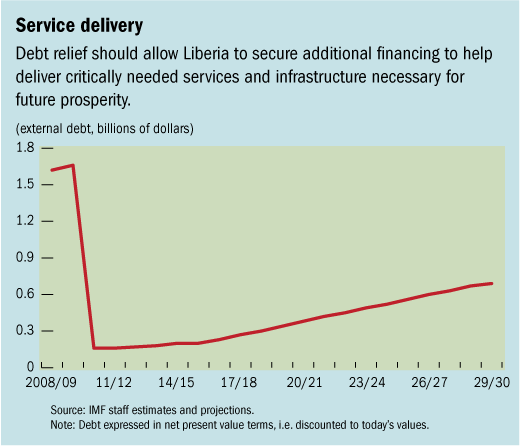DEBT RELIEF FOR AFRICA

Typical street scene in Santa Ana, El Salvador. (Photo: iStock)
IMF Survey: Liberia Wins $4.6 Billion in Debt Relief from IMF, World Bank
June 29, 2010
- Debt relief milestone should catalyze further support from donors
- Priority to unblock bottlenecks that inhibit private sector investment
- Macroeconomic conditions broadly favorable for growth recovery in 2010
The IMF and the World Bank decided to support June 29 the final stage of debt relief for Liberia that in total amounts to $4.6 billion in nominal terms.

Lumber production in Liberia, where projected growth recovery is based on revival of ore mining, forestry, commercial farming (photo: Ray Bird/Corbis)
Debt relief reduces Liberia’s external debt stock by more than 90 per cent (see chart) to about 15 percent of GDP.
The decision was reached after the west African country met the requirements for achieving the final step, or completion point, under the enhanced Heavily Indebted Poor Countries (HIPC) Initiative. The IMF’s share of this debt relief amounts to about $730 million in end-June 2007 present value terms—among the largest IMF country commitments under the enhanced HIPC Initiative, representing over one-fifth of the total financial support for the HIPC process. Liberia’s graduation from the HIPC process brings to 29 the number of countries reaching the HIPC completion point—the stage at which full and irrevocable debt relief is won.
The HIPC Initiative was launched in 1996 by the IMF and the World Bank to ensure that no poor country faces a debt burden it cannot manage. It entails coordinated action by the international community, including multilateral organizations, governments, and private creditors. In 1999, the initiative was modified to provide faster and broader debt relief and to strengthen the links between debt relief, poverty reduction, and social policies.
Future prosperity
"Debt relief would allow Liberia to secure additional financing, in initially modest amounts, to help deliver critically needed services and infrastructure necessary for Liberia’s future prosperity,” IMF First Deputy Managing Director John Lipsky said on a visit to Monrovia, Liberia earlier this year. “Liberia’s own economic and social policies, political stability, and above all continued peace and security will be of paramount importance for delivering the better Liberia that we all hope for,” he added.

President Ellen Johnson Sirleaf said she had been confident that Liberia would meet the HIPC completion point despite challenges. “We concentrated on building the institutions, getting the laws, getting our public financial management law passed, making sure we got a general auditing commission that's functioning, making anti-corruption effective,” she said.
On a visit to IMF headquarters in advance of the debt relief decision, Augustine Ngafuan, Liberia’s Minister of Finance, said debt relief is an important step for Liberia but no panacea. “We will continue to be geared toward consolidating macroeconomic stability and fostering conditions conducive to rapid and sustainable growth and employment creation as well as poverty reduction.”
Notable track record
Following a ruinous period of over two decades of warlordism and civil war, Liberia had a shattered economy and the highest debt-to-GDP ratio in the world. In this context, the authorities agreed to the appointment of external financial controllers in key agencies including the Ministry of Finance, the central bank, and important state enterprises under a donor-funded governance and economic management program to support financial management. As domestic capacity improved, the financial controllers were withdrawn.
Following the inauguration of President Johnson Sirleaf in January 2006, Liberia established an encouraging track record of macroeconomic management and structural reform under an IMF staff monitored program, with additional support through intensive technical assistance and policy advice.
In March 2008, the country formally began the debt relief process when it reached the interim stage, or decision point, under the HIPC Initiative and embarked on a three year IMF-supported financial program. Comprehensive debt relief was linked to demonstrating a commitment to poverty reduction, sound macroeconomic policy, strong public financial and resource management, and governance reform.
Life after debt
The granting of debt relief marks a significant milestone in Liberia’s path toward recovery. Macroeconomic conditions are broadly favorable for a recovery of growth in 2010, based on a revival of iron ore mining, forestry, and commercial agriculture. “The immediate challenge is to focus investment on roads, electric power, and ports to unblock bottlenecks that inhibit private sector investment,” said Amara Konneh, Liberia’s Minister of Planning and Economic Affairs.
Nonetheless, considerable tasks remain, including maintaining macroeconomic stability alongside expansionary fiscal policies, strengthening governance and the rule of law, catalyzing external financing with high quality public investment plans, and developing the financial sector to support private savings and investments.
The next program review by the IMF will address the main risks to successful implementation of the authorities’ growth strategy, such as gaining cost competitiveness outside of extractive industries, strengthening institutions, and medium-term budgetary planning.
IMF mission chief for Liberia Chris Lane said IMF involvement with Liberia has been sustained and intensive, and will remain so for some time to come. “After this debt relief milestone, the Fund program should catalyze further financial support from the donor community,” Lane said.







